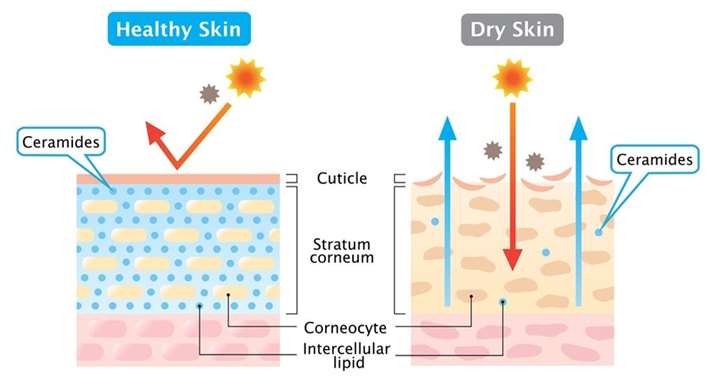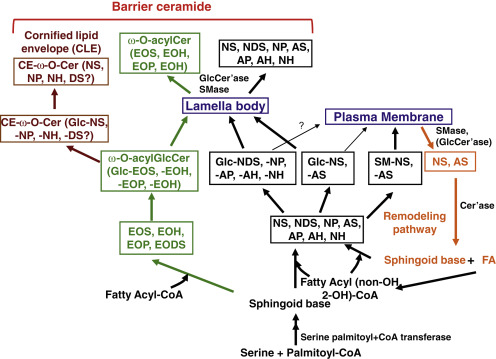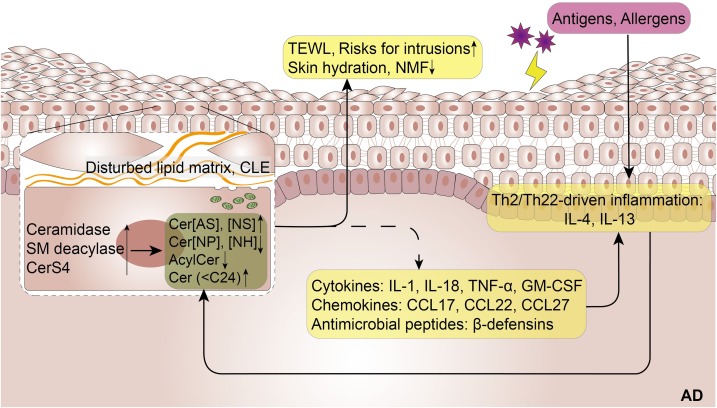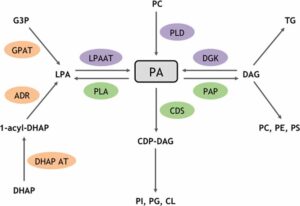What are Ceramides?
Ceramide is synthesized and secreted by lamellar vesicles, which together with cholesterol and free fatty acids form intercellular lipids involved in maintaining skin barrier function. Ceramides can act as second messengers to directly regulate downstream signaling molecules and also form lipid rafts or lipid micro-regions in the cell membrane to participate in signal transduction and protein transport. Currently, 16 different isoforms of ceramides have been identified in the skin stratum corneum, of which 12 are free extractable isoforms and the other 4 are linked to the cytokeratin sheath and are difficult to extract and measure individually.

Naming of Ceramides
There are currently two naming systems for ceramides. One is based on the chromatographic migration order as ceramides 1 to 8; and after that, the chronological order of discovery as ceramides 9 to 11. The other method is based on the molecular structure naming. The final letters are sphingosine groups, including S (sphingosine), dS (dihydrosphinganine), P (phytosphingosine) and H (6-hydroxy sphingosine). The preceding letters represent acyl chains and include N ( no-hydroxy, non-hydroxy), A ( α-hydroxy), and EO (linoleic acid esterified ω-hydroxy).
What Are The Benefits of Ceramide for Skin?
- Involved in forming the skin barrier
The amphiphilic nature of ceramides allows barrier lipids to form a membrane-like intercellular lipid layer. Hydrophilic groups promote epidermal hydration and prevent excessive transepithelial water loss. Ceramides promote the synthesis of filaggrin (FLG), an important structural protein and a major source of moisturizing factors.FLG monomers polymerize to form keratin bundles, which are involved in maintaining the structure and integrity of the stratum corneum.FLG is enzymatically catalyzed and broken down into free amino acids and other natural moisturizing factors, including urea, sodium pyrrolidone carboxylate, and lactic acid.
 Barrier ceramide formation (Sakamoto et al., 2017).
Barrier ceramide formation (Sakamoto et al., 2017).
- Involved in signal transduction
Intracellular ceramides can act as messenger ceramides to act as second messengers in various biological processes. Messenger ceramides are of similar origin to non-messenger ceramides and do not differ significantly in chemical structure, including the epidermis-specific ω-O-acyl-ultra-long chain ceramides. However, most of the precursors of non-messenger ceramides (glucosyl ceramides) are located within the lamellar vesicles and cannot enter directly into the cytosol without being involved in signaling.
In addition to being an essential structural part of biological membranes, lipids, including sphingolipids, are increasingly recognized as important regulators of many important cellular processes, including autophagy.
The main mechanisms of ceramide induced autophagy include.
(1) Inhibition of the activity and expression of silk/threinine protein kinase (Akt), an inhibitor of autophagy. Under normal physiological conditions, it inhibits autophagy by activating the mammalian target of rapamycin (mTOR) kinase. Ceramide negatively regulates the phosphatidylinositol-3-kinase (PI3K)/Akt pathway, thereby inducing autophagy.
(2) Promotion of autophagy-related gene Beclin 1 expression and function. Ceramide can directly promote Beclin 1 gene expression and also increase Beclin 1 expression by activating the protein kinase c-Jun amino-terminal kinase (JNK), which inhibits Bcl-2 binding to BH-3 of Beclin 1, thereby inducing autophagy production.
- Regulate skin immunity
Skin lipids play an important role in immune regulation and inflammatory responses. Sphingosine was first found to have antibacterial properties in a Mycobacterium tuberculosis-related study in 1948. One study found that sphingosine, dihydrosphingosine and phytosphingosine had similar antibacterial activity against a range of Gram-positive and Gram-negative bacteria (including Escherichia coli, Clostridium difficile, Staphylococcus aureus, and Streptococcus). These sphingosine bases accumulate in the bacterial cell membrane and induce damage to the bacterial ultrastructure. The specific mechanism may be related to the insertion of sphingosine bases into the polar lipids in the cytoplasmic membrane (Gram-positive and Gram-negative bacteria) and the inner leaflets of the outer membrane (Gram-negative bacteria), causing changes in the physical properties of the bacterial cell membrane and loss of membrane function.
Ceramide Metabolism Abnormalities Causing Skin Diseases
- Psoriasis
Psoriasis patients have abnormal skin ceramide content and fractions. The ceramide subtype composition was altered in psoriatic lesions. Compared to the surrounding non-lesioned skin, ceramide EOS, NP and AP levels are decreased, while the total amount of ceramide in the psoriatic lesion area is not significantly abnormal. It has been suggested that the decrease in long-chain fatty acid-containing ceramides in psoriatic lesions may be related to the reduction of mRNA expression of elongase of long-chain fatty acids (ELOVL) and ceramide synthase in keratin-forming cells by interferon in the skin of patients.
- Atopic dermatitis (AD)
The clinical severity of AD and the total ceramide level were negatively correlated. In the lesions of AD patients, the content of large-molecular-weight ceramide isoforms decreased while the content of small-molecular-weight ceramide isoforms increased.
 Alteratered ceramide profile is actively involved in the pathogenesis of AD (Li et al., 2020)
Alteratered ceramide profile is actively involved in the pathogenesis of AD (Li et al., 2020)
- Acne Vulgaris
There are abnormalities in ceramide levels in the skin of acne patients. NH, AH and EOS and EOH levels are reduced in acne-involved skin compared to levels in healthy skin.
Creative Proteomics has extensive experience in ceramides analysis. Based on liquid chromatography-electrospray ionization-tandem mass spectrometry (LC-ESI-MS/MS) platform, we can help our customers with lipidomics analysis and facilitate basic research.
References
- Sakamoto, K., Lochhead, H., Maibach, H., & Yamashita, Y. (Eds.). (2017). Cosmetic science and technology: theoretical principles and applications. Elsevier.
- Li, Q., Fang, H., Dang, E., & Wang, G. (2020). The role of ceramides in skin homeostasis and inflammatory skin diseases. Journal of Dermatological Science, 97(1), 2-8.













